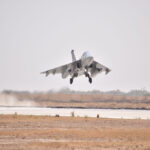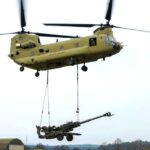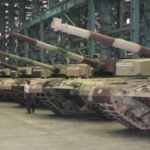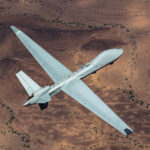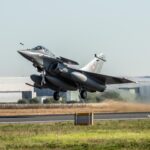Helicopter production to dominate Indian military aviation market.
Fighter jets second production line

A strong ‘make in India’ pitch will form the future of military aviation in India over the next two decades. Helicopters will drive the market as the Indian armed forces – the Army, the Indian Air Force (IAF) and Navy – along with the coast guard need some 1000 copters. These will be under the make in India category and some of these will be for civilian use as well.
New fighter jets and transport planes will add to the work for Indian companies in sheer dollar-value. New Delhi plans to spend billions of dollars in raising a military aviation manufacturing complex. Indian private sector can take advantage of the Indian Government’s ‘Make In India’ policy by participating in the ‘Buy and Make’ (India) category. The Indian Army and the Indian Air Force would be acquiring these light helicopters under a separate ‘Buy and Make’ (India) category.
Indian companies will get to working at the offsets of foreign products. Under the Defence procurement procedure (DPP) ‘offset’ is the work or components a foreign company has to source from an Indian company or supplier. Normally 30 percent of a contract value is the offset.
The Aero-India 2017 which opens in Bangalore in February will further define the path of progress which has been spelt out by Defence Minister Manohar Parrikar.
Helicopters and the possibilities: The ageing fleet will need to be replaced and additional copters have to be added for newer roles for surveillance roles and rescue emerging at sea and in the mountains.
The three services need 484 Light utility helicopters to replace Cheetah/Chetak fleet of helicopters for which Army requires 259, IAF 125 and Navy needs around 100 such helicopters and equipped with anti-submarine warfare (ASW) capabilities. The Army and Air force need some 180 attack helicopters. The Coastguard and other Paramilitary forces have their own requirements which are nearly 100 copters. Navy needs another 50 twin-engined helicopters for ship-deck launch operations. It also wants 147 multi-role helicopters with anti-submarine warfare capabilities classified as Naval Multi Role Helicopter (NMRH). Sikorsky S-70B Seahawk has been selected for the first 16, the Navy plans to build remaining 123 helicopters indigenously in India.
Eleven Indian private sector companies, which include Tata Advanced Systems, Bharat Forge, Reliance Defence and Aerospace, Mahindra Aerospace and L&T have responded to the Naval demand. These Indian companies have proposed to form joint ventures with three foreign companies Airbus, Bell Helicopters and Agusta Westland.
For the non-Navy demand, public sector giant Hindustan Aeronautics Limited (HAL) is making the 5.5 tonne class Light Combat Helicopter (LCH). The LCH is its latest offering after having produced some 200 advanced light helicopters (Dhruv) , some 40 of the weaponised Dhruv called the Rudra. The LCH It is currently under development and undergoing weapons integration. The Indian Army’s Aviation Corps has expressed its intention to acquire 114 helicopters and the IAF 65, however, no contract has been signed so far. HAL is also on board to produce the 197 Kamov 226—T helicopters with Russia.
Industry participation is possible for landing gear, self sealing fuel tanks, armor protection, day/night targeting systems including the Helmet Pointed Sight and electro-optical pod and counter measures dispensing system (CMDS).
The Coast Guard is final stages of buying 14 of the EC-725 medium weight copters from Airbus for its shore-based fleet to carry out surveillance and search and rescue missions there. The hub for the Coast Guard choppers would be set up in Goa were it will have maintenance, repair and overhaul (MRO), which means a major role for local industry in offsets.
The last lot is the foreign purchases. The India US deal includes an option to buy an additional seven Chinook and 11 Apache helicopters. These will be beyond the already contracted 15 and 22, respectively. Both copters are produced by US company Boeing .
The fighter jets: One part of the plan is of ramping up existing make in India projects like Tejas fighter jet from the existing 8 per year to 16 per year. The IAF has placed an order of 123 LCA Tejas fighter jets, production has started and these will be rolled out over the next 8-10 years. The plane has 59.7 per cent local content by value and 75.5 per cent by numbers, it will come with 43 improvements and most of it will be sourced from within India. In November 2016 Minister of State for Defence Subhash Bhamre told Lok Sabha there are a total of 344 LRUs (Line Replaceable Units) involved in the system level of Tejas, of which of 210 have been produced indigenously. The second part of the plan is a strategic partnership formula, a forthcoming policy, that will allow Indian Private companies to set-up joint ventures with foreign collaborators and Indian Air Force Chief Arup Raha announced at a press conference on December 28 that 200 additional fighter jets are needed to tide over the shortage of jets. India has officially announced that it will have a second fighter jet production line – the first one being the Tejas made by HAL. It is learnt the second line will be single engine fighter and the companies in race are HAL with its Tejas Mark-2 (the much more powerful GE 414 engine has been selected for this), the Gripen produced by Saab of Sweden and the F-16 produced by US company Lockheed Martin. Defence Minister Parrikar has announced on January 3 that the second line will be set up under the strategic partnership model. The Ministry of Defence will select the Indian strategic partner – a private company — to join hands with the foreign company.
The Transport planes: The TATA-Airbus joint venture is already an example to produce a new generation C-295 transport plane from the Airbus stable. A total 62 are on order ( 56 for the IAF and six for maritime surveillance by the coast guard). These will be made in India. For the maritime aircraft, the Defence Research and Development Organisation (DRDO) will design and develop state of art mission suite of advanced electronic systems like oil spills or looking across maritime boundaries to detect suspicious movement towards Indian waters.





